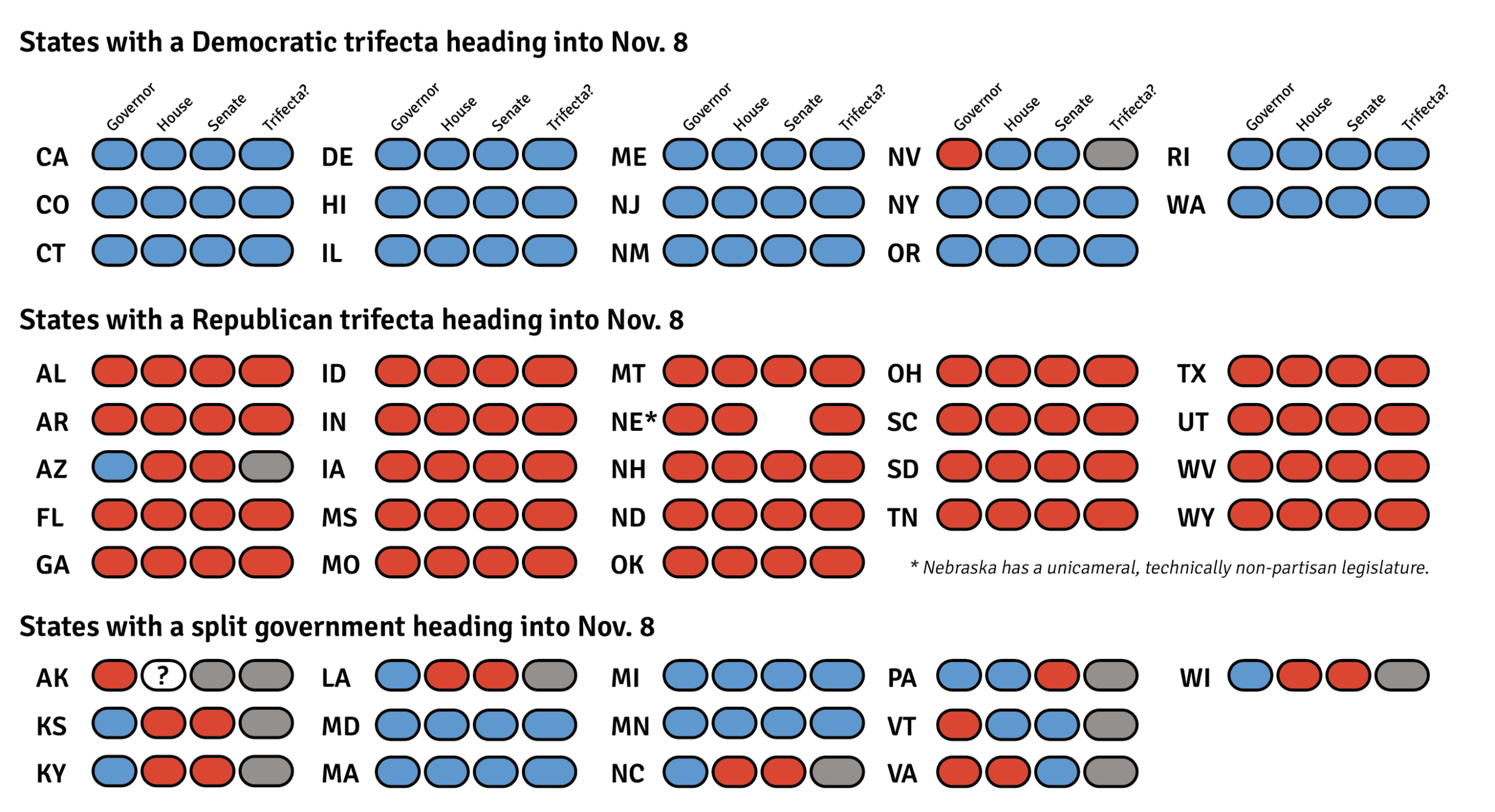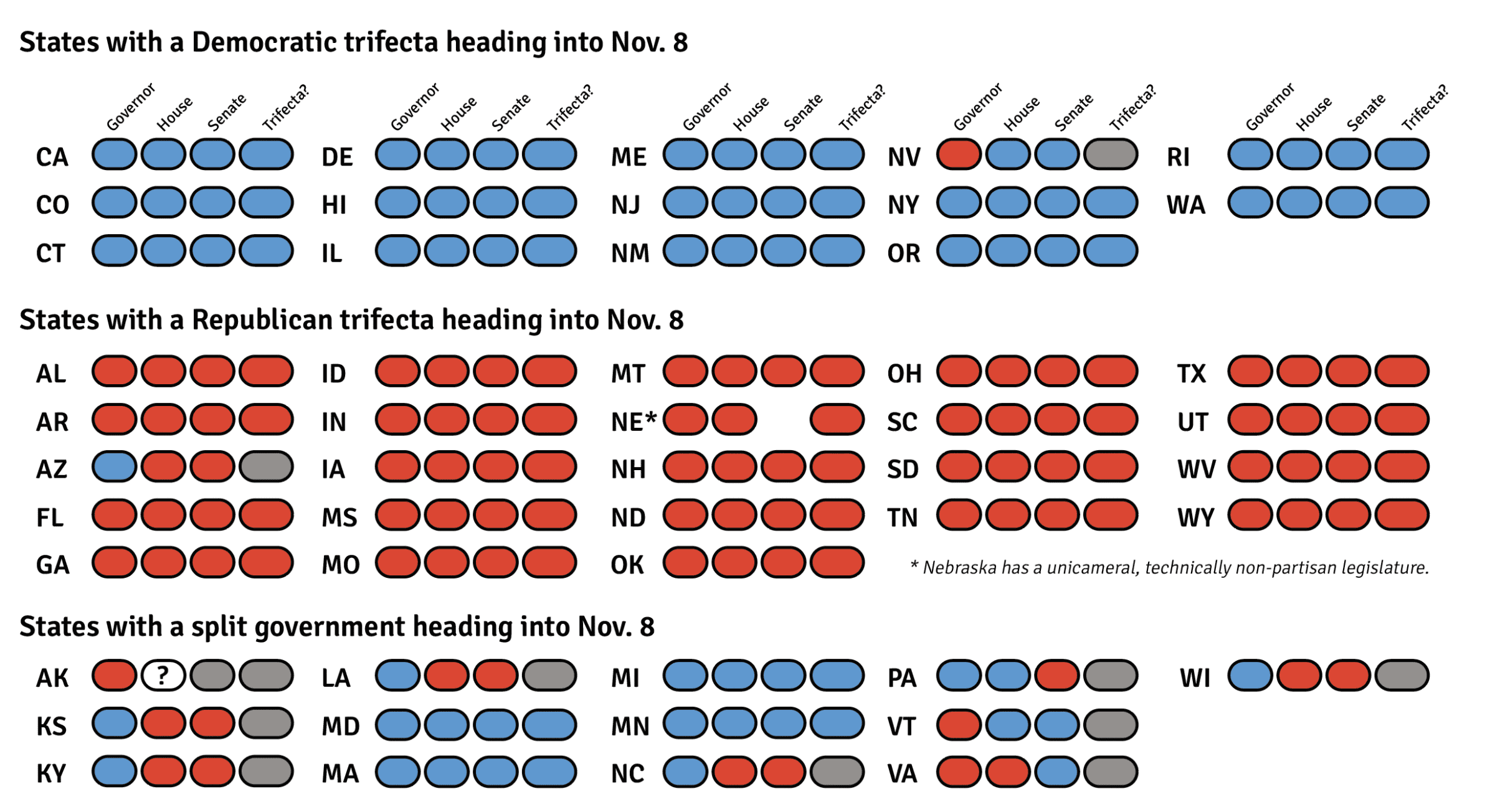In Legislative Elections, Democrats Defied Recent History
The GOP’s seat gains are minuscule by the standards of past midterms, a state-by-state analysis by Bolts finds. And only Democrats flipped chambers.
Daniel Nichanian | November 29, 2022


Editor’s note: The article was updated on Jan. 19, 2023, to reflect the resolution of recounts and legal battles that were still pending as of publication, in roughly a dozen races across the country. Due to lead changes in some districts, these updates shifted the national swing by two seats.
Republicans were confident that they would build up power in statehouses and inflict a “bloodbath” on Democrats. Instead, they failed to win any new legislative chamber, their seat gains are minuscule by recent standards, and their strongest showings are concentrated in places they already dominate.
Democrats, meanwhile, flipped four legislative chambers and allied with centrist Republicans to wrestle a fifth chamber away from the GOP.
The results have deflated conservative ambitions to channel backlash against the sitting president to leap ahead in states, like they did in 2010 and 2014. Two years into President Barack Obama’s term, in 2010, the GOP gained more than 600 legislative seats and unleashed a torrent of right-wing laws that undercut unions and restricted voting rights. In 2014, they gained roughly 250 seats, according to data compiled by Ballotpedia. Democrats returned the favor in 2018 by gaining more than 300 legislative seats, powered by President Donald Trump’s widespread unpopularity.
No such wave occurred in 2022. Republicans gained only 20 legislative seats this fall out of more than 6,000 that were on the ballot, according to Bolts’s review of the results. (Editor’s note: The analysis was updated in January with final results in a dozen races that were pending recounts as of publication. One election in New Hampshire ended in an exact tie after a recount.)
And it gets worse for Republicans. While they managed to net a few seats overall, their biggest gains came in chambers that they already massively control, such as the West Virginia or South Carolina houses, or else in New York, where they are deeply in the minority.
By contrast, Democrats soared in closely-divided legislatures and seized four previously GOP-held chambers: Michigan’s House and Senate, Minnesota’s Senate, and Pennsylvania’s House. In addition, the GOP seems to have lost control of Alaska’s Senate; a group made up of centrist Republicans and Democratic senators announced on Friday that they would form a coalition to run the chamber. We may not know until 2023 if a similar coalition emerges in the Alaska House, or if the GOP can coalesce to win control of that chamber.
This table details the partisan make-up of each state chamber, plus the D.C. council, before and after the Nov. 8 elections.
| Senate Before | Senate After | GOP gain or loss | House Before | House After | GOP gain or loss | |
| Alabama | 27 R 8 D | 27 R 8 D | 0 | 78 R 22 D | 78 R 22 D | 0 |
| Alaska* | 13 R 7 D | 3 R Coalition: —8 R —9 D | -2 | 19 R Coalition: —2 R —4 I —9D | 21 R 6 I 13 D | 0 |
| Arizona | 16 R 14 D | 16 R 14 D | 0 | 31 R 29 D | 31 R 29 D | 0 |
| Arkansas | 28 R 7 D | 29 R 6 D | +1 | 78 R 22 D | 82 R 18 D | +4 |
| California | 31 D 9 R | 32 D 8 R | -1 | 60 D 19 R 1 I | 62 D 18 R | -2 |
| Colorado | 21 D 14 R | 23 D 12 R | -2 | 41 D 24 R | 46 D 19 R | -5 |
| Connect. | 23 D 13 R | 24 D 12 R | -1 | 97 D 54 R | 98 D 53 R | -1 |
| Delaware | 14 D 7 R | 15 D 6 R | -1 | 26 D 15 R | 26 D 15 R | 0 |
| D.C. council | 11 D 2 I | 11 D 2 I | 0 | |||
| Florida | 26 R 14 D | 28 R 12 D | 2 | 78 R 42 D | 85 R 35 D | 7 |
| Georgia | 34 R 22 D | 33 R 23 D | -1 | 103 R 77 D | 101 R 79 D | -2 |
| Hawaii | 24 D 1 R | 23 D 2 R | +1 | 47 D 4 R | 45 D 6 R | +2 |
| Idaho | 28 R 7 D | 28 R 7 D | 0 | 58 R 12 D | 59 R 11 D | +1 |
| Illinois | 41 D 18 R | 40 D 19 R | +1 | 73 D 45 R | 78 D 40 R | -5 |
| Indiana | 39 R 11 D | 40 R 10 D | +1 | 71 R 29 D | 70 R 30 D | -1 |
| Iowa | 32 R 18 D | 34 R 16 D | +2 | 60 R 40 D | 64 R 36 D | +3 |
| Kansas | 29 R 11 D | 29 R 11 D | 0 | 86 R 39 D | 85 R 40 D | -1 |
| Kentucky | 30 R 8 D | 31 R 7 D | +1 | 75 R 25 D | 80 R 20 D | +5 |
| Louisiana | 27 R 12 D | 27 R 12 D | 0 | 69 R 2 I 34 D | none up | 0 |
| Maine | 22 D 13 R | 22 D 13 R | 0 | 82 D 3 I 66 R | 82 D 2 I 67 R | +1 |
| Maryland | 32 D 15 R | 34 D 13 R | -2 | 99 D 42 R | 102 D 39 R | -3 |
| Mass. | 37 D 3 R | 37 D 3 R | 0 | 130 D 1 I 29 R | 134 D 1 I 25 R | -2 |
| Michigan | 22 R 16 D | 20 D 18 R | -4 | 57 R 53 D | 56 D 54 R | -3 |
| Minnesota | 34 R 2I-with-R 31 D | 34 D 33 R | -3 | 70 D 64 R | 70 D 64 R | 0 |
| Mississippi | 36 R 16 D | none up | 0 | 76 R 3 I 43 D | 76 R 3 I 43 D | 0 |
| Missouri | 24 R 10 D | 24 R 10 D | 0 | 114 R 49 D | 111 R 52 D | -3 |
| Montana | 31 R 19 D | 34 R 16 D | +3 | 67 R 33 D | 68 R 32 D | +1 |
| Nebraska | 32 R 17 D | 32 R 17 D | 0 | |||
| Nevada | 12 D 9 R | 13 D 8 R | -1 | 26 D 16 R | 28 D 14 R | -2 |
| New Hampshire | 14 R 10 D | 14 R 10 D | 0 | 211 R 189 D | 201 R 198 D 1 tie | -10 |
| New Jersey | 24 D 16 R | 24 D 16 R | 0 | 46 D 34 R | 46 D 34 R | 0 |
| New Mexico | 26 D 1 I 15 R | none up | 0 | 45 D 25 R | 45 D 25 R | 0 |
| New York | 43 D 20 R | 42 D 21 R | +1 | 107 D 43 R | 102 D 48 R | +6 |
| North Carolina | 28 R 22 D | 30 R 20 D | +2 | 69 R 51 D | 71 R 49 D | +2 |
| North Dakota | 40 R 7 D | 43 R 4 D | +3 | 80 R 14 D | 82 R 12 D | +2 |
| Ohio | 25 R 8 D | 26 R 7 D | +1 | 64 R 35 D | 68 R 31 D | +4 |
| Oklahoma | 39 R 9 D | 40 R 8 D | +1 | 82 R 19 D | 81 R 20 D | -1 |
| Oregon | 18 D 1 I 11 R | 17 D 1 I 12 R | +1 | 37 D 23 R | 35 D 25 R | +2 |
| Penn. | 28 R 1 I-with-R 21 D | 28 R 22 D | -1 | 113 R 90 D | 102 D 101 R | -12 |
| Rhode Island | 33 D 5 R | 33 D 5 R | 0 | 65 D 10 R | 65 D 1 I 9 R | -1 |
| South Carolina | 30 R 16 D | none up | 0 | 81 R 43 D | 88 R 36 D | +7 |
| South Dakota | 32 R 3 D | 31 R 4 D | -1 | 62 R 8 D | 63 R 7 D | +1 |
| Tennessee | 27 R 6 D | 27 R 6 D | 0 | 73 R 26 D | 75 R 24 D | +2 |
| Texas | 18 R 13 D | 19 R 12 D | +1 | 85 R 65 D | 86 R 64 D | +1 |
| Utah | 23 R 6 D | 23 R 6 D | 0 | 58 R 17 D | 61 R 14 D | +3 |
| Vermont | 21 D 2 Prog. 7 R | 22 D 1 Prog. 7 R | 0 | 92 D 7 Prog. 5 I 46 R | 104 D 5 Prog. 3 I 38 R | -8 |
| Virginia | 21 D 19 R | none up | 0 | 52 R 48 D | none up | 0 |
| Wash. | 28 D 1 D-with-R 20 R | 29 D 20 R | 0 | 57 D 41 R | 58 D 40 R | -1 |
| West Virginia | 23 R 11 D | 30 R 4 D | +7 | 78 R 22 D | 88 R 12 D | +10 |
| Wisconsin | 21 R 12 D | 22 R 11 D | +1 | 61 R 38 D | 64 R 35 D | +3 |
| Wyoming | 28 R 2 D | 29 R 2 D | +1 | 51 R 2 I 7 D | 57 R 5 D | +6 |
I attributed vacant seats to the party that held them most recently. For the purpose of quantifying a swing and being consistent, I counted lawmakers who left their party since the last election but did not join or caucus with the other party as belonging to their original party. (This applied to one lawmaker in each of Arkansas, Minnesota, New Hampshire, New Mexico, and Tennessee.) I counted lawmakers who outright switched parties, or who left their original party to caucus or ally with the other party, as belonging to their new party. In addition, I counted the Alaska and Washington lawmakers who remain in one party but caucus with another as belonging to the party they were elected with and have chosen to keep affiliating with.
Below are five takeaways from what transpired in state legislatures.
1. Democrats land new trifectas
Democrats may have lost a small number of seats this cycle—overall, they will have about a dozen fewer seats than before, if current results hold—but they hit the jackpot due to how their gains and losses were spread out.
In flipping the Michigan legislature and the Minnesota Senate, Democrats took full control of these states’ governments. This is a historic achievement for Michigan Democrats, who have not enjoyed a trifecta—one-party control of both legislative chambers and the governorship—in nearly 40 years.
Democrats also gained two trifectas in Maryland and Massachusetts, where they already controlled the legislature, when Democrats Wes Moore and Maura Healey won gubernatorial elections to replace outgoing GOP governors.
Democrats lost their trifecta in Nevada when Democratic Governor Steve Sisolak lost, even as they strengthened their legislative majorities there. Of course, they also lost their trifecta in the federal government. In addition, Democrats gained new supermajorities in the Vermont legislature, which will give them the ability to override vetoes by Republican Governor Phil Scott.


Republicans, by contrast, gained no new trifecta. They also failed to gain new veto-proof legislatures in states where Democratic governors wield the veto pen. And they lost control of Arizona’s state government for the first time since 2009: Democrat Katie Hobbs will replace the outgoing Republican governor even as the GOP keeps bare legislative majorities.
In all, an additional 26 million Americans will live in states run by Democratic trifectas as a result of the 2022 midterms. Seven million fewer Americans will live in states run by GOP trifectas.
2. Legislative shifts bring big policy ramifications
Michigan and Minnesota may be the two most intriguing states heading into the 2023 legislative sessions given their new Democratic majorities. In 2018 and 2019, Colorado and Virginia Democrats similarly gained control of a legislature after long being locked out of power, and they rapidly adopted a flurry of progressive priorities such as abolishing the death penalty.
Democrats in Michigan and Minnesota have already signaled a desire to strengthen labor and environmental laws. The shifts will also have major repercussions for criminal justice policy and voting rights. Minnesota Democrats are pushing for legislation legalizing marijuana, while Michigan Democrats will now have authority to oversee the implementation of new voting protections that the electorate approved in November.
Pennsylvania Democrats won’t control the entire state government since the GOP retains the state Senate, but their new majority in the House has huge implications: It immediately kills a package of constitutional amendments that would have restricted abortion rights, among other drastic changes. Republicans in the legislature were looking to get around the governor’s veto power, but this required them to pass amendments they adopted this year in next year’s session again. “We stopped these constitutional amendments in their tracks,” a Pennsylvania Democrat told CBS.
In the 35 states where one of the parties defended their existing trifecta—including California, Illinois, and New York for Democrats, and Georgia, Florida, and Texas for Republicans—upcoming legislative sessions will see the heaviest activity, with measures strengthening or restricting access to abortion likely to be at the frontlines.
Among many issues, Bolts will track the fate of abortion rights in GOP-run states—Florida Republicans have already signaled they will champion new restrictions—and keep an eye on whether New Mexico and Oregon Democrats return to landmark voting rights bills that stalled this year. In Rhode Island, a pair of lawmakers who have experienced the criminal legal system from the inside are now looking to bring more awareness to the burdens of re-entry for formerly incarcerated residents.
3. Republicans solidify power in red states
Eight years ago, Democrats still controlled both chambers of the West Virginia legislature. Now they can barely win elections in the state.
Republicans gained 17 legislative seats in West Virginia alone—by far their biggest jump anywhere—which accounts for much of their nationwide progress and gives them gigantic majorities of 30-4 and 88-12 in the state Senate and House.
Republicans similarly strengthened their dominance in Kentucky, another state where Democrats ran the legislature a decade ago but where the GOP will now enjoy majorities nearly as large as in West Virginia. The GOP also gained at least five seats in each of Arkansas, South Carolina, and Wyoming.
Republicans’ most dramatic gains came in Florida, where a combination of a strong GOP performance, dismal Democratic turnout, heavy conservative spending, voter intimidation, and newly-drawn gerrymanders gave the party supermajorities in both chambers. Still, Republicans already dominated state politics, though their new margins will further enable them to sideline Democrats and circumvent legislative rules, The Miami Herald reports.
Republicans also gained a supermajority in the heavily-gerrymandered Wisconsin Senate; they have already signaled they may use that margin to remove Democratic officials from office. But they failed to win a supermajority in the lower chamber, which will keep them from overriding Democratic Governor Tony Evers’s vetoes, and an early vacancy in a somewhat competitive Senate district gives Democrats a shot to erase the supermajority.
The GOP also fell just short of its goal to secure a supermajority in Nebraska’s ostensibly nonpartisan unicameral legislature, which will enable Democrats to continue blocking bills like tax cuts through the chamber’s generous filibuster rules; but pro-choice advocates are already warning that one Democratic senator’s opposition to abortion may allow Republicans to push through an abortion ban.
4. And Democrats solidify power in blue states
Mirroring Democrats’ growing struggles in the South, Republicans keep sinking further in Colorado. The state’s upper-chamber was under GOP control as recently as four years ago, but Democrats expanded their majority this fall to a large 23-12 edge; in the state House, they gained a new supermajority.
Other blue states also doubled down. Democrats gained seats and solidified supermajorities in Massachusetts, Maryland, and likely California, and gained new veto-proof majorities in Vermont. New York Democrats also appear to have retained the supermajorities they painstakingly gained in the 2020 cycle, despite losing ground. The exception is Oregon, where a three-seat loss means that Democrats will no longer enjoy the three-fifth majorities that are needed to pass tax bills.
What made a difference in the parties’ fortunes is that Democrats’ largest gains came in swing states: They will have 13 more seats in Pennsylvania and at least 10 more in New Hampshire; those are the only two states other than West Virginia that saw double-digit seat swings. (The GOP will have a bare majority in the New Hampshire House.) And while the shifts in Michigan and Minnesota were comparatively very small, Democrats got exactly what they needed: they flipped three chambers with no seats to spare.
5. Independent maps and gerrymanders made a difference
Throughout the 2010s, Michigan voted under maps gerrymandered by the GOP. This enabled Republicans to retain the legislature even when Democratic candidates won more votes. In 2018, voters approved a measure to impose an independent redistricting process, and 2022 was the first cycle held under maps freed of the Republican gerrymander.
The outcome: Democrats once again won the popular vote; and this time, that secured them actual majorities.
Other states used maps that were drawn by courts or independent redistricting panels, including Arizona, California, Colorado, and Pennsylvania. But many other legislative battles were waged under heavily gerrymandered maps. That includes Illinois and Maryland on the Democratic side, and large red states—Florida, Tennessee, Texas—for the GOP.
Georgia and Wisconsin stick out as rare states that are very competitive in federal elections but where a party—Republicans in each case—has effectively locked down legislative majorities through its control of the mapping process. In Wisconsin, Republicans will control 86 seats going forward, to Democrats’ 46, despite the state being evenly divided.
In red states, one effect of GOP gerrymanders was a large decline in the number of so-called majority-minority districts, seats where people of color make up a majority. An analysis by Pluribus News shows that the drop is most pronounced in Florida and Texas, where Republicans drew new maps.
State advocates were already denouncing this when the maps were drawn last year. “How do we face the challenges in the places of Texas we all call home if our voting power is taken from us?” Valerie Street, president of Our Vote Texas, told The Texas Tribune in 2021.
An earlier version of the article contained an incorrect spelling of the name of Massachusetts Governor-Elect Maura Healey.
Sign up and stay up-to-date
Support us
Bolts is a non-profit newsroom that relies on donations, and it takes resources to produce this work. If you appreciate our value, become a monthly donor or make a contribution.


